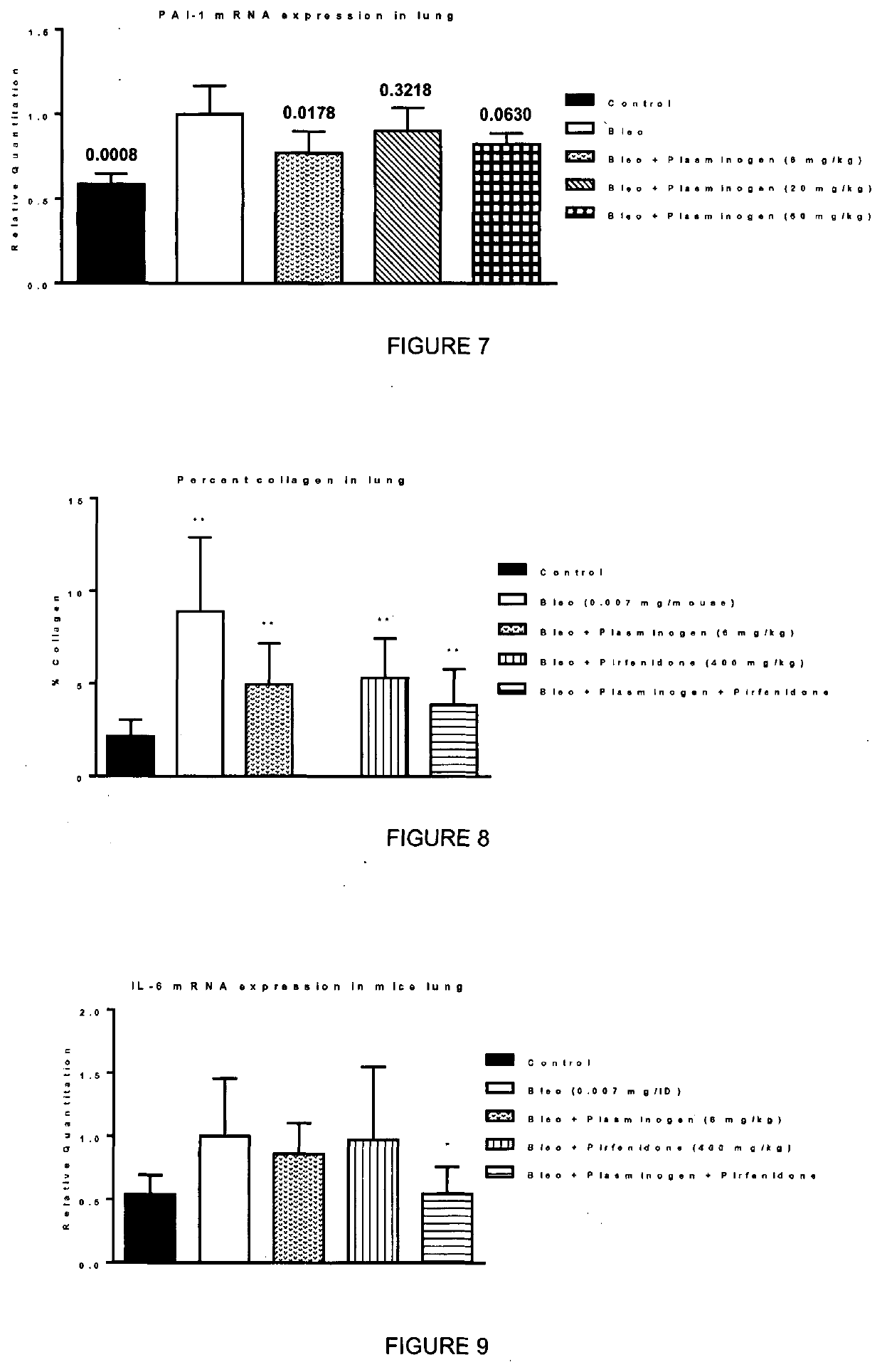Plasminogen treatment of conditions associated with pai-1 overexpression
- Summary
- Abstract
- Description
- Claims
- Application Information
AI Technical Summary
Benefits of technology
Problems solved by technology
Method used
Image
Examples
example 1
en Preparation
[0055]Plasminogen is purified from pooled human plasma that is sourced from FDA / EMA-licensed US plasma collection centers. The resulting purity is above 95%. The purified plasminogen is composed of Glu-plasminogen wherein 95% or more of the plasminogen is a monomer form. The Glu-plasminogen was prepared as described previously in PCT publication WO 2006 / 120423.
[0056]Human plasminogen is comprised of approximately 75 milligrams per vial of lyophilized plasminogen. Prior to infusion, the lyophilized powder in a vial is reconstituted with 12.5 mL of water for intravenous injection. The final composition contains sodium citrate, sodium chloride, glycine and sucrose for providing an acceptable protein stability, ionic strength and pH.
example 2
f Plasminogen in Pulmonary Fibrosis Mouse Model
[0057]Pulmonary fibrosis in mice is induced by intratracheal instillation of bleomycin into the mouse. Bleomycin is well-known anticancer drug. First, the bleomycin insult results in an acute inflammation as soon as day 1. Later at about day 10 to day 14, fibrotic events arise and create a chronic fibrotic condition. The bleomycin-induced mice is recognized as an animal model for pulmonary fibrosis. The evaluation of the activity of plasminogen is undertaken by treatment of the mice with plasminogen at appropriate time points. In the present study, plasminogen was administered at day 10 and day 14.
[0058]Male C57BL6 mice are administered intratracheal instillation of bleomycin sulphate (0.007 mg / mouse) at day 0. Human plasminogen was administered subcutaneously at day 10 and day 14, at a dose of either 6 mg / kg, 20 mg / kg, or 60 mg / kg. Animals were sacrificed at day 21. Collagen was quantified by histologic analysis using the staining Red ...
example 3
f Plasminogen Combined with a Fibrotic Agent in Pulmonary Fibrosis Mouse Model
[0065]Pulmonary fibrosis in mice is induced by intratracheal instillation of the anticancer drug bleomycin into the mouse. The experiment was performed as described in Example 2, except that murine plasminogen has been administered. Male C57BL6 mice are administered intratracheal instillation of bleomycin sulphate (0.007 mg / mouse) at day 0. Murine plasminogen was administered subcutaneously at days 7, 10, 13, 16 19 and 23, at a dose of 6 mg / kg, alone or in combination with oral administration of 400 mg / kg of pirfenidone (once a day, from day 7 to day 27). Animals were sacrificed on day 28. Collagen was quantified by histologic analysis using the staining Red sirus staining (Fluorescence) and analysed as described in Example 2. IL-6 mRNA expression was quantified by real-time PCR using mouse Taqman® Gene-Expression assay normalized to HPRT1 endogenous control (Student's t-test).
[0066]This experiment has tes...
PUM
| Property | Measurement | Unit |
|---|---|---|
| Fraction | aaaaa | aaaaa |
Abstract
Description
Claims
Application Information
 Login to View More
Login to View More - R&D
- Intellectual Property
- Life Sciences
- Materials
- Tech Scout
- Unparalleled Data Quality
- Higher Quality Content
- 60% Fewer Hallucinations
Browse by: Latest US Patents, China's latest patents, Technical Efficacy Thesaurus, Application Domain, Technology Topic, Popular Technical Reports.
© 2025 PatSnap. All rights reserved.Legal|Privacy policy|Modern Slavery Act Transparency Statement|Sitemap|About US| Contact US: help@patsnap.com



